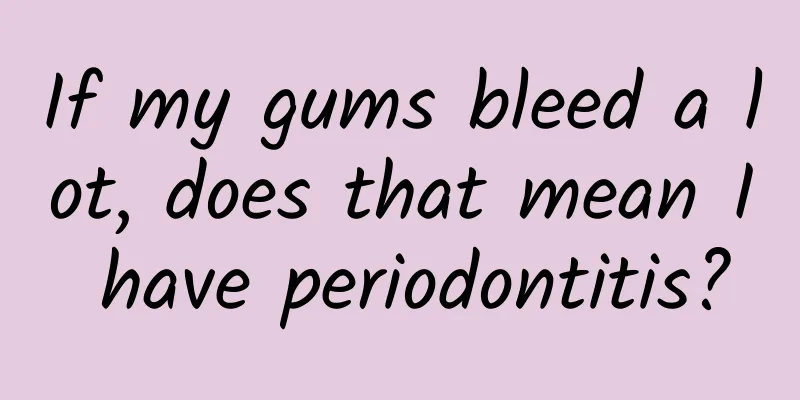If my gums bleed a lot, does that mean I have periodontitis?

|
This is the 3563rd article of Da Yi Xiao Hu Many people may have heard that bleeding gums are one of the main symptoms of periodontitis. So, does bleeding gums mean that you have periodontitis? If not, what else could be the problem? Not simple periodontal disease Although periodontitis is often the first thing that comes to mind when we talk about periodontal disease, from the perspective of professional classification of periodontal disease, periodontitis in a narrow sense (actually chronic periodontitis) is only one of the nearly ten types of periodontal disease. According to the current classification method, periodontal disease can first be divided into two major categories: gum disease and periodontitis, and gum disease and periodontitis are further divided into several types. Chronic periodontitis is indeed the most common type of periodontitis. There are four main clinical symptoms of periodontitis: gingival inflammation and bleeding, periodontal pocket formation, alveolar bone resorption, and loose and displaced teeth. Therefore, gingival bleeding is indeed one of the objective indicators that can reflect the presence or absence of periodontitis. However, on the other hand, gingival bleeding cannot be equated with the occurrence of periodontitis. This is because, in the classification of periodontal diseases, the most common type of gingival disease is gingivitis, which can also cause gingival bleeding. Therefore, when there are symptoms of gingival bleeding, the patient may suffer from either periodontitis or gingivitis. Both are periodontal diseases and have symptoms of bleeding gums. How to distinguish whether it is gingivitis or periodontitis? The difference between gingivitis and periodontitis stems from the different scope of their lesions. In the former, inflammation only affects the gingival tissue, while in the latter, on the basis of gingivitis, deeper tissues - the periodontal membrane, alveolar bone and cementum are also affected. Therefore, there are obvious differences in the manifestations of the two. It is important to “see it through” Non-professionals cannot distinguish between gingivitis and periodontitis based on the symptom of bleeding gums alone. Only professional doctors can distinguish them using professional methods. Periodontitis, on the one hand, causes more severe gum inflammation - the gums bleed and separate from the tooth surface, as if they were lifted up, and form so-called periodontal pockets; on the other hand, it manifests as inflammation of deeper periodontal tissues, which damages the periodontal membrane and alveolar bone. When the damage reaches a certain extent, the teeth may become loose or even shifted. For us, the most critical issue is to detect the signs of tissue damage as early as possible. So, what methods can help us find these signs? Dentists have two magic weapons: periodontal probes and panoramic radiographs. During routine oral examinations, there is an instrument called a probe. The periodontal probe is different from ordinary probes in that it has two features: one is that the tip of the needle is rounded and blunt, and the other is that the tip of the needle has scales. These features are closely related to its use - it is mainly used to check periodontal pockets, that is, to detect the location and depth of periodontal pockets. The rounded tip can prevent it from causing pain and puncture to the gums, and the scale can show the depth of the periodontal pockets. Normal gums also have a small part separated from the tooth surface, which forms a shallow groove between the gums and the tooth surface - the gingival sulcus. However, the depth of the gingival sulcus is usually less than 3 mm. Periodontal pockets are different. Their depth may reach 5 to 10 mm. The basis for their formation is that on the one hand, the part of the gums separated from the tooth surface increases, and on the other hand, the speed of gum atrophy is slower than the speed of the gums separating from the tooth surface. Obviously, the depth of the periodontal pocket can reflect the severity of periodontitis. In routine oral examinations, radiographic examination is also a very common examination method. In the process of periodontal disease examination and diagnosis, the most commonly used method is to take a panoramic radiograph, whose scientific name is full-mouth curved tomographic radiograph. Its outstanding advantage is that it can give a panoramic view of the alveolar bone condition of the entire mouth of teeth. Through panoramic radiographs, dentists can see whether the alveolar bone has been absorbed, as well as the position of the teeth where the absorption has occurred and the severity, etc., thereby assisting in the diagnosis of whether periodontitis exists and formulating a periodontal treatment plan. The situation of alveolar bone absorption can also reflect the severity of periodontitis. However, this indicator cannot be judged by the naked eye, and only radiographic examinations can help us "see through" the internal condition of the alveolar bone. Therefore, to confirm whether it is gingivitis or periodontitis, you cannot rely on guesswork alone. Only after professional examination can you draw a conclusion. Gingivitis does not necessarily mean periodontitis Although everyone knows how to distinguish between gingivitis and periodontitis, some people still worry, "Will my gingivitis develop into periodontitis?" Although both of them damage the gums, periodontitis is not an "upgraded version" of gingivitis. In other words, just because a person has gingivitis now does not mean that he will have periodontitis in the future, because not all gingivitis will develop into periodontitis. Research data show that the vast majority of people (81%) have slow progression of gingivitis, only a small number of people (8%) have rapidly worsening conditions, and another group of people (11%) have a static condition that does not develop into periodontitis. However, some studies have also shown that gingivitis is often regarded as a prodromal symptom and risk factor for periodontitis, so it is also important to actively prevent gingivitis. Therefore, it is the right choice for us to take a positive and objective attitude towards gingivitis and periodontitis. We should neither be indifferent nor be overly nervous. Author: Shanghai Health and Health Development Research Center rich Some pictures are taken from the Internet. If there is any infringement, please let us know and they will be deleted. All names and place names are pseudonyms and any similarity is purely coincidental. |
<<: Why are Moringa seeds bitter at first and sweet later? How to choose Moringa seeds
>>: Listeria - This "killer" is a bit cold
Recommend
What should women eat for postpartum high blood pressure?
Hypertension is a symptom that we are all very fa...
How long does it take for a blood hcg test to produce results?
As people grow up, they will always encounter phy...
Is it normal to have your period 12 days early?
Under normal circumstances, women's menstrual...
What is a pelvic cystic mass?
The pelvic cavity mainly refers to the area cover...
What is the cause of bleeding during 7 months of pregnancy?
Many people think that it is unlucky to see blood...
Why do women urinate frequently, urgently, and urinate blood?
Nowadays, there is a phenomenon of frequent urina...
Treatment of pelvic cysts
Cysts in the pelvic cavity are harmful to women&#...
How many people have been infected with HPV59 positive
How many people have been infected with HPV59 and...
The principle of contraceptive pills to regulate menstruation
What is the principle of contraceptive pills in r...
Can I use enema for constipation in late pregnancy?
Many pregnant women will experience many adverse ...
[Medical Q&A] What should cancer patients do after bone metastasis?
Planner: Chinese Medical Association Reviewer: Ko...
When does a woman's body turn red?
The "sexual expression" of the areola i...
Stomach tightness and hardness after spotting
Before giving birth, some women will experience s...
What causes nipple pain in women
Women grow up slowly during puberty due to the st...









